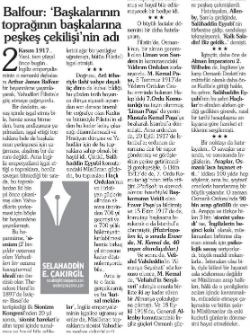Within October 30 - November 5, 2017, three news articles that generate hate speech were selected from the print media. You can find these articles that generate hate speech against the Syrians, British, Jews and Greeks as well as the analyses written about them below.1
1.
Alican Değer, in his column titled “If the Greek army came, it would not occupy there”, gives a statement in the title that he quotes from someone else within the text. In this way, he regenerates the prejudices and negative sentiments against the Greek identity.
|
2.
Selahaddin E. Çakırgil, in his column titled “Balfour: ‘The name of making other people’s territory available to others” writes: “But then this calamity took place and these ‘holy places’ were occupied by the British imperialism and they made Muslim territories available to the Zionist Jews”. With these remarks he reinforces negative sentiments against the British and the Jews. The author also writes: “The claim ‘Arabs betrayed Ottomans’ of the British during those wars and afterwards has been made for 100 years, but this is a huge lie told with devilish intentions” and “3000 ‘Zionist Jews’ who speak Arabic and Turkish were fighting a psychological war to create enmity among Muslims as the 'fifth arm of the British'. With these remarks, he attributes the incidents to the British and Jewish identities and designates them as an enemy of the Muslims.
|
3.
The article that was published in the newspaper Türkiye titled “Syrian bride hit twice” emphasizes the national identity of the suspect and associates the Syrian identity with crime. The newspaper thus fuels the already existing prejudice towards Syrians in the society.
|
1. Within the scope of the media monitoring work focusing on hate speech, all national newspapers and around 500 local newspapers are monitored based on pre-determined keywords (e.g. Traitor, apostate, refugee, Christian, Jewish, separatist, etc.) via the media monitoring center. While the main focus has been hate speech on the basis of national, ethnic and religious identities; sexist and homophobic discourses are also examined as part of the monitoring work.




